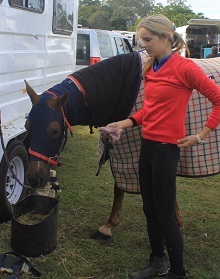Learn to Select and Properly Care For a Horse
An introductory course for beginners or new owners, Horse Care I will help you understand how to select a horse that suits your needs, manage general grooming and care, and develop a general rapport with your animal through an understanding of horse psychology.
During this course, you'll work toward developing the ability to handle horses using a range of different procedures, skills to evaluate a horses conformation, an understanding of diet, knowledge of commercial opportunities, including trading horses, and more.

Course Duration: 100 hours
Course Structure
There are seven lessons in this course.
1. Horse psychology and handling
- The early horse
- Survival mechanisms of the early horse
- The modern horse: behaviour and memory
- Using psychology to handle horses
- Catching and leading horses
- Fitting the bridle and saddle
- Tying up a horse
- Safety rules
2. Buying a horse
- Temperament
- Size
- Weight carrying ability
- Age
- Equine dentition and aging
- Glossary of terms
- Dentition diagrams and detailed explanation
- Colour and markings
- Breeds
3. Conformation
- The shape of the skeleton
- Body proportions and parts
- Conformation problems
- How to describe confirmation
4. The digestive system and principles of feeding and watering
- The digestive system
- The alimentary canal
- The stomach
- The small intestine
- The large intestine
- Absorption of food
- Groups of food nutrients
- The composition of some common horse feeds
- The principles of watering
- The principles of feeding
- Feeding concentrates and roughage
- Feeding groups of horses at one time
5. The grass kept horse and pasture management
- Advantages and disadvantages of working off grass
- Paddock size and minimum area needed
- Types of fencing
- The water supply
- Shelter
- Fodder trees
- General management of the grass-kept horse
- Management in summer
- Management in winter
- Exercise
- Grooming the grass-kept horse
- Conservation of the land
- Keeping horses at grass on small areas
- Roughing off and turning a horse out
6. Grooming
- The skin: epidermis, dermis, the coat
- How the skin regulates body temperature
- Reasons for grooming
- Grooming tools
- Grooming techniques: strapping, sponging, brushing
- Using a stable rubber, dealing with stable stains on grey coats
- Oiling the feet
- Quartering
- Setting Fair/Brushing off
- Washing the mane and tail
- Washing the sheath
- Shampooing the horse
7. Industry Applications
- Resources
- Writing resumes: employment readiness
- Competition horses (overview) - event horse, dressage horse, show jumper, endurance
- Educating Horses
- Breeding
- Farm planning
- Short term operations
- Farm business structures
- Quality management systems
- Whole farm planning
- Preparing a farm business
- Managing risk
- Sensitivity analysis
- Financial management
- Record keeping
- Finance sources
- Setting up a small business
Enrol Today
Ready to get started? Click on the orange enrol now button.
Have questions? Click here to email our course counsellors.
Ensuring Your Horse is Physically Sound and Well-Cared For
Skeletal and Muscular Systems
Like the human skeleton, the horse’s skeleton has three major functions. The skeleton provides protection for major organs, it supports soft tissues and soft parts of the body. It provides a framework for the attachment of muscles. Horses have 205 bones which are divided into two parts referred to as the appendicular and axial skeleton. The appendicular skeleton is the limbs (legs) and the axial skeleton is the skull, vertebrae, ribs and sternum.
If interested in exercise science, foaling and breeding, veterinary science or chiropractic and massage therapy for horses, then deep knowledge of the skeleton and joints is required. The muscular system attaches to the skeleton system through a number of tendons. A broad thin sheet of muscles lie directly under the skin covering the neck, abdomen and chest. This muscular sheet is attached to the skin through fibrous tissue. The muscles of the neck, back and loin are found tightly position against the underside of the spine. movement of the horse is controlled by the contraction and relaxation of certain muscles and muscle groups. An example of this is the forward extension of the neck which is controlled by the muscles which extend between the poll and withers and the small muscles which connect certain vertebrae.
Cardiovascular System
The cardiovascular system, made up of the heart, blood and blood vessels, and the respiratory system, trachea and lungs, work to together to supply oxygen and nutrients to the tissues and organs of the horse. We can say the lungs (found within the chest cavity) are responsible for respiration and blood subsequently delivers the oxygen to the cells and tissues of the body. We call breathing respiration. The act of drawing air into the lungs is called inspiration and the forced push of air out of the lungs is called is called expiration.
Pulse rate:
Adult horse: 30-40 beats per minute (resting rate).
Nursing foal: 70-90 beats per minute (resting rate).
Exercise improves overall fitness. As blood volume increases, circulation improves and the heart pumps more blood with less effort. This means overall the volume of oxygen that is delivered to cells each minute increases. During exercise, as the breathing rate increases, several muscles are used to increase the chest cavity and allow for fuller expansion of the lungs.
Healthy breathing and cardiovascular health is demonstrated by quiet, relaxed breathing with no anomalous coughs or sneezes. Also a consistent rhythmic heart beat should be heard. Clean and clear nostrils are also a good sign. Breathing problems on the other hand could be seen through irregular, increased or laboured breathing; reduced ability to cope with periods of exercise and longer recovery times after exercise.
Praise for this Course:
"I learnt many new skills that are easily applied to day to day runnings."
A. Green